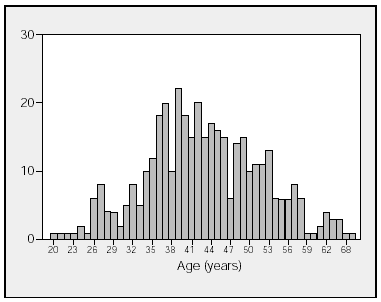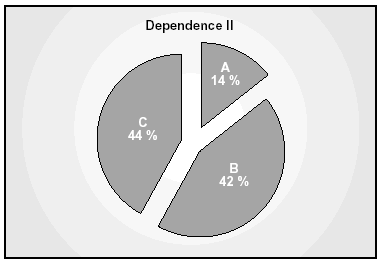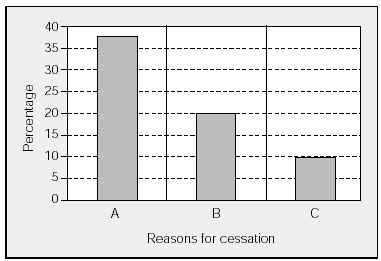Introduction
The variety of smoking cessation therapies that have proven effective ranges from simple counseling to intensive interventions using medications -- either nicotine replacement therapy or bupropion -- in combination with cognitive-behavioral therapy1-5.
At present smoking is considered a chronic disease, given that it is a process that persists over time with periods of improvement (abstinence) and with a strong tendency to relapse1. As with other chronic diseases the treatment strategy should include both primary and specialized care. Various primary care protocols6 exist which identify the characteristics of smokers who can benefit from smoking cessation programs.
As is the case with other chronic health conditions, it is also necessary to define the level of the specialized care provided by smoking cessation clinics. To date, Spain has had relatively limited experience with these clinics. Though recommendations have been made as to how they should be organized and operated in this country7, they are presently covered by the public health system only in certain autonomous regions where they have been set up.
Smoking is the primary cause of preventable morbidity and mortality in developed countries8. According to the latest National Health Survey carried out in 2001 by the Ministry of Health, 34% of the population in Spain over the age of 16 smokes9. This high prevalence, together with the enormous cost of treatment of smoking-related diseases, underlines the need for therapeutic interventions aimed at reducing the numbers of smokers. As some authors have affirmed2,10, smoking cessation treatment is a priority intervention among the policies aimed at controlling smoking, given that treatment directly affects smoking-related morbidity and mortality in a population and therefore is the most cost-effective intervention in the short term, justifying the development of therapeutic services available at all levels of the system.
The objective of our study was to describe the profile of smokers who seek treatment at a smoking cessation clinic and thus contribute to establishing treatment criteria at a level of specialized care.
Material and methods
A descriptive observational study was carried out. The target population comprised smokers who voluntarily sought treatment at the Smoking Cessation Clinic of the University of Zaragoza School of Medicine (FMZ). The clinic is located in the School of Medicine and offers free treatment to smokers wishing to quit, under an agreement between the University of Zaragoza, the regional autonomous government of Aragon and an insurance company (Mutua de Accidentes de Zaragoza). The patients were representative of the general urban population and were either self-referred or referred to the clinic by their doctor at the workplace or a family physician. In all cases the smokers personally sought access to the program through an initial telephone call to the clinic.
The following variables were studied: sex; age; referral source; marital status; educational level; age at which smoking began, age at which it became a regular habit and the time elapsed between the two moments; level of nicotine dependence (measured by the Modified Fagerström Questionnaire for Nicotine)11; number of cigarettes smoked per day; number of years smoking; use of other potentially-addictive substances (alcohol, caffeine, psychotropic medications and other drugs); presence of concomitant disease; previous attempts to quit smoking; current reasons for smoking cessation; and expired air carbon monoxide (CO).
All of the patients seeking treatment at the smoking cessation clinic were placed on a waiting list; following that, an appointment was arranged for each, at which time the smoker's medical history was taken in order to gather data on the study variables and measure weight, blood pressure and CO in expired air. These individuals were then enrolled in a multicomponent treatment program (utilizing medication and psychotherapy). In all cases, the choice of pharmacologic therapy was discussed and agreed upon with the smoker in advance and determined according to the degree of nicotine-dependence previously diagnosed in the first interview. Either combined nicotine replacement therapy (fast-acting nicotine substitutes and/or the transdermal patch system) or bupropion was prescribed, depending upon the individual characteristics of each smoker and possible contraindications.
Severe psychiatric disorders or concurrent dependence on another addictive substance were considered exclusion criteria for patients seeking multi-component group smoking cessation treatment.
Expired air CO was measured with a CO-oximeter (Mini Smokerlyzer, Bedfont Scientific Ltd.), and findings above 10 ppm12 identified an individual as a smoker.
Nicotine dependence, as measured by the Fagerström Test, was considered low for individuals scoring 0 to 3; average for those scoring between 4 and 6; and high for those with scores above 713.
SPSS software in a Windows® operating system was used for the database, statistical analysis and data handling. The results are presented in percentages and means with standard deviations (SD) and 95% confidence intervals (CI).
Results
The population sample comprised 385 smokers -- 239 (62%) men and 146 (38%) women -- with an average age of 43.05 years (SD: 9.07; 95% CI, 42.14-43.96 years). Figure 1 shows the sample distribution according to age.
Fig. 1. Distribution of subjects by age (numbers are percentages).
In 67.3% of the cases, subjects were referred to the clinic by their workplace physician, 17.4% were referred by their primary care physician and the remaining 15.3% were self-referred. The majority of the participants (72.5%) were married and 83% had children. Thirty-three percent of the study sample had received a basic education (elementary or early secondary schooling), 39% had received higher secondary education or vocational training and the remaining 28% had attended university.
Ninety-two of the participants began smoking between the ages of 8 and 20, the average age being 14.83 years (SD: 4.27; 95% CI, 14.40-15.27 years). The average age at which smoking became a regular habit was 17.7 years (SD: 4.59; 95% CI, 17.32-18.25 years). The mean interval of time between the age at which smoking began and the age at which it became a regular habit was 3 years (SD: 3.01; 95% CI, 2.69-3.30 years).
The mean Fagerström test score was 6.05 points (SD: 2.19; 95% CI, 5.83-6.27); 14% of the study sample scored as having low dependence (0-3); 42% medium dependence (4-6), and 44% high dependence (scores of 7 and above) (Fig. 2). Responses to the Fagerström questionnaire showed that 32.1% of the subjects smoked their first cigarette of the day within 5 minutes of waking and 35.5% smoked more than 30 cigarettes per day.
Fig. 2. Degree of nicotine-dependence. A: low dependence (0-3). B: moderate dependence (4-6). C: high dependence (>7).
The average number of cigarettes smoked per day was 25.9 (SD: 12.11; with 95% CI, 24.74-27.18 cigarettes per day), and the average number of years smoking was 25.3 (SD: 9.04); the mean concentration of CO in expired air measured at the initial interview (before smoking cessation) was 39.30 ppm (SD: 25.18; 95% CI, 36.75-41.84 ppm).
A study of the concomitant use of other potentially-addictive substances showed the following results: 26% of the subjects consumed alcohol on a daily basis, 92% consumed caffeine daily and 18% were taking psychotropic medications at the time the medical history was taken. Seven percent of the sample group had experimented with other drugs such as marijuana and cocaine though none of the subjects was using those substances at the time of the study.
Associated disease was present as chronic bronchitis for 27.5% of the sample studied while 9% had history of peptic ulcers, though none active at the time of the initial interview, and cardiovascular risk factors were present for 15%.
Seventy-two percent of the smokers in the study had tried to quit smoking on previous occasions; of these, 122 (46%) had made only one attempt at smoking cessation, and theirs was the most frequently encountered situation in our study population. The main reasons for giving up smoking were the prevention of disease (38%), awareness of dependence (20%) and parental desire to serve as a positive role model for children (10%) (Fig. 3).
Fig. 3. Reasons for cessation. A: prevention of disease. B: awareness of dependence. C: parental model for children.
Discussion
The individuals seeking treatment at this smoking cessation clinic were referred by their doctor at the workplace, their primary care physician or were self-referrals, indicating to us that it is a heterogeneous, representative sampling of smokers wishing to quit. The reason the majority of participants in this study were from work-related referrals is due to the fact that when the FMZ Smoking Cessation Clinic first went into operation its primary links were with clinics in the workplace. Nonetheless, regardless of the referral source, each participant voluntarily came to the clinic for smoking cessation treatment, which was offered at no cost other than for the purchase of medications that are not presently covered by the Public Health Service in Spain.
The fact that potential participants personally contacted the clinic by telephone to seek treatment and then were placed on a waiting list, served as a way to screen out smokers who, in accordance with the stages of change proposed by Prochazka and DiClemente14, were neither ready nor sufficiently motivated to quit smoking. When the medical histories were taken each subject chose his or her own quitting date, another criterion that indicates the individual is ready for smoking cessation13.
The average age of the subjects in the study was 43 years and most of the smokers showed no smoking-related disease. Approximately a quarter of the study sample (27.5%) presented with chronic bronchitis. That prevalence is lower than that described for smokers15, probably directly owing to the average age of the subjects studied. Thus, we can generally define the group as young adult smokers with no smoking-related diseases. One study on smoking cessation carried out in Spain16 describes very different characteristics for smokers who quit. The differences are probably due to the methodology used, given that the variables in that study were drawn indirectly from an analysis of a National Health Survey and referred to exsmokers. Thus, the target group was not the same as that in our study and therefore could not serve as a valid point of comparison.
The prevalence of psychotropic medication use in the population at large has been determined to be slightly lower (14%)17,18 than that found in our study (18%), possibly owing to specific emotional and personality traits of smokers as yet not fully understood19.
The higher percentage of men to women in the sample studied reflects the current tendency of men to quit smoking in greater numbers than women. This observation is consistent with Stage 3 of the epidemiological model described by López et al20, which includes Spain, and with statistics gathered from a recent population survey in Catalonia (Spain)21,22.
We observed that the average age at which subjects began to smoke was 14.8 years (between 8 and 20 years of age), with a mean interval of 3 years between the age at which smoking began and the age at which it became a regular habit. These figures match those in the literature23,24.
The Fagerström test for nicotine dependence shows overall results of moderate dependence (mean value of 6)12, though individual analysis of questionnaire results for this group of smokers indicates that a minority (14%) of the subjects had low dependence and the majority had medium or high dependence, consistent with the mean concentration of expired CO (39.3) found. Along these same lines it has been postulated that smokers with low nicotine-dependence are able to quit smoking on their own while more severely nicotine-dependent smokers are those who seek smoking cessation treatment25.
An analysis of the two most weighted items in the Fagerström test26 (time elapsed before the first cigarette and number of cigarettes smoked per day) showed that one-third of the subjects smoked their first cigarette within 5 minutes of waking and smoked more than 30 cigarettes per day (32% and 35.5%, respectively); this finding is of interest because it sheds further light on degree-of-dependence and indicates that one-third of the subjects seeking smoking cessation treatment fit a severely nicotine-dependent profile as described by some authors27. Degree of dependence could be related to the average age of the subjects in the sample population (43 years) and is in keeping with a recent study of smokers in Europe which reports that the most severely nicotine-dependent smokers fall with the range of 35 to 65 years of age28.
The majority of the subjects (72%) had made a past attempt to quit smoking, which can be interpreted as indicating a high degree of dissonance and is consistent with the profile of this group as being, generally speaking, at the stage of preparing to quit29. We observed that the most frequently cited reason for wanting to quit smoking was prevention of disease -- in keeping with reports from other studies30 -- though other significant factors included awareness of dependence and parental desire to serve as a positive role model for children. Understanding the reasons behind smokers' desire to quit can be helpful in designing specifically-targeted smoking cessation interventions linked with both public and preventive health care policies.
The subjects enrolled in this smoking cessation clinic were not pre-selected to fit the described profile of the subgroup of smokers needing specialized treatment7; nonetheless, the results show this population sample to be severely nicotine-dependent young adults with a strong desire to quit smoking but showing no concomitant disease.
In the near future, with the development of a stepped-care model of smoking-cessation intervention in which treatment of smokers would come under the umbrella of primary and specialized care -- as is the case with any other chronic health problem31 -- we will see a larger sample group of people seeking specialized treatment. This will include a greater number of smokers with diseases (chronic obstructive pulmonary disease, heart disease, psychiatric disorders) as well as other specific groups of smokers such as pregnant women, older-aged smokers, etc. who do not currently represent a significant percentage of people seeking treatment at smoking cessation clinics. The few Spanish publications reporting on smoking cessation clinics and intensive interventions have demonstrated the efficacy of such programs32-35. Such reports will require us to direct resources to specialized smoking cessation services in Spain, a recommendation which has in fact been made in a recent report by the Ministry of Health and Consumer Affairs36.
Correspondence: Dr. I. Nerín.
Departamento de Medicina y Psiquiatría. Facultad de Medicina, edificio B. Domingo Miral, s/n. 50009 Zaragoza. Spain
E-mail: isabelne@posta.unizar.es
Manuscript received 1 August 2002.
Accepted for publication 12 October 2002.















